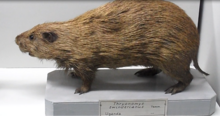| Thryonomyidae | |
|---|---|

| |
| Greater cane rat (Thryonomys swinderianus) | |
|
Scientific classification
| |
| Domain: | Eukaryota |
| Kingdom: | Animalia |
| Phylum: | Chordata |
| Class: | Mammalia |
| Order: | Rodentia |
| Parvorder: | Phiomorpha |
| Family: |
Thryonomyidae Pocock, 1922 |
| Genera | |
|
1 living and many extinct, see text | |
Thryonomyidae is a family of hystricognath rodents that contains the cane rats (Thryonomys) found throughout sub-Saharan Africa, and a number of fossil genera.
Taxonomy
Thryonomyidae was formerly more diverse and widespread, with fossil relatives found in India and Arabia as well. [1] The extinct genus Sacaresia from the island of Mallorca off Spain may also be a member of this family, [2] though its position remains uncertain.
- Genus †
Epiphiomys
- †Epiphiomys coryndoni
- Genus †
Gaudeamus
- †Gaudeamus aegyptius
- Genus †
Kochalia
- †Kochalia geespei
- Genus †
Monamys
- †Monamys simonsi
- Genus †
Neosciuromys
- †Neosciuromys africanus
- Genus †
Paraphiomys
- †Paraphiomys afarensis
- †Paraphiomys hopwoodi
- †Paraphiomys knolli
- †Paraphiomys occidentalis
- †Paraphiomys orangeus
- †Paraphiomys pigotti
- †Paraphiomys renelavocati
- †Paraphiomys shipmani
- Genus †
Paraulacodus
- †Paraulacodus indicus
- †Paraulacodus johanesi
- Genus †
Protohummus
- †Protohummus dango
- Genus †
Sacaresia?
- †Sacaresia moyaeponsi
- Genus Thryonomys
Former fossil members of the family include the genus Apodecter and two species of Paraphiomys (australis and roessneri), which have now been transferred to the related Petromuridae. [3]
References
- ^ Lopez Antonanzas, R. (2004). "Systematics and phylogeny of the cane rats (Rodentia: Thryonomyidae)". Zoological Journal of the Linnean Society. 142 (3): 423–444. doi: 10.1111/j.1096-3642.2004.00136.x. hdl: 10261/44218.
- ^ van der Geer, Alexandra; Lyras, George; de Vos, John (2011). Evolution of Island Mammals: Adaptation and Extinction of Placental Mammals on Islands. Wiley. p. 183. ISBN 9781119675747.
- ^ Sallam, H.M.; Seiffert, E.R. (2019). "Revision of Oligocene 'Paraphiomys' and an origin for crown Thryonomyoidea (Rodentia: Hystricognathi: Phiomorpha) near the Oligocene–Miocene boundary in Africa". Zoological Journal of the Linnean Society. 190 (1): 352–371. doi: 10.1093/zoolinnean/zlz148.